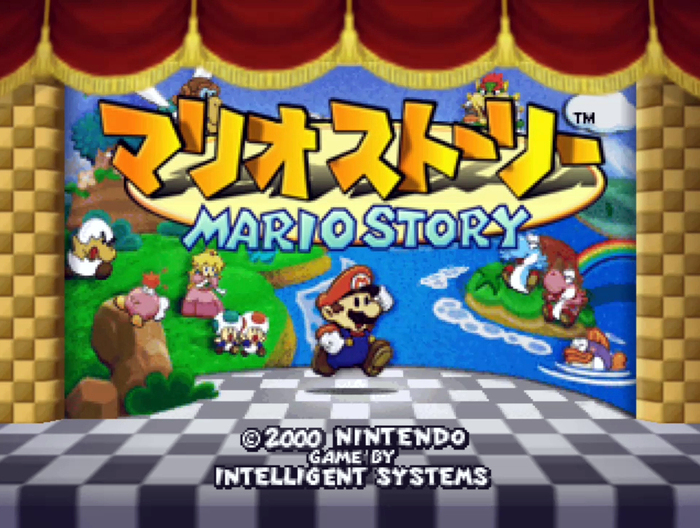Notes on Combat Systems in Paper Mario
I recently played through Paper Mario for the first time. I'd played it a little when it first came out, but quickly got distracted and put it aside. Coming back to it after all these years the whimsical attitude was wonderful, but the combat system was particularly interesting for how much conventional JRPG design it throws out the window.

The title screen from the Japanese Wii store version I played.
The way I see it there are essentially two major variations on traditional Dragon Quest or early Final Fantasy style combat in JRPGs: the Pokemon route, where type relations play a major role, and the semi-action-RPG system introduced in Super Mario RPG, where attack and defense can be improved by timed button presses. While there are certainly many other innovations in turn-based RPGs, these are the only two that have inspired numerous imitators without becoming completely different genres like tactics-style RPGs.
So, to go over the distinctive features of the combat system quickly:
Action Commands, originally called Timed Attacks in Super Mario RPG, make their return. By pushing a button at the right time, attacks can do more damage or enemy attack damage can be reduced. This gives players a reason to pay attention even in mundane battles.
Taking a page from Pokemon, multiple types of basic attack avoid the situation where simple battles devolve into choosing "attack" repeatedly. There's no such thing as "just an attack" in Pokemon because every action is subject to type interactions. While Paper Mario doesn't have that much variety, splitting basic attacks between jumping and using a hammer means that you have to choose the correct action for each enemy. For example, the hammer can't reach flying enemies, while jumping on enemies with spikes hurts Mario.
All stats in the game use small numbers - by the end of the game Mario will have at most around 50HP and do around eight damage with a typical attack. The final boss has just 99HP - compare to the 2000HP of the final boss in FF1. A single point of extra damage every round can change the number of turns it takes to defeat a common enemy, altering your battle strategy entirely.
Attack damage is not random - each attack (from Mario, friends, or enemies) has a fixed base damage, typically altered only by action commands. A few items can add miss chance under certain conditions, but there's no critical hits and in general randomness is de-emphasized. The main source of unpredictability is in enemy attack patterns. This allows you to plan ahead further than in some RPGs - you might know you'll need to heal in five turns but not before, for example.
Allies in combat don't act as full characters - they don't have HP and by default they can't use items. They also share the reserve of FP for special moves with Mario. Each has their own attack patterns and special attacks that change the strategic space of the game. This is a brilliant compromise that makes the attack space in combat similar to RPGs with multi-character parties while avoiding the complexity of managing the HP and MP of each character individually.
Badges are items that allow you to get small bonuses or change the rules of the game. Each badge requires a number of Badge Points, limiting how many you can equip at one time, so gaining a badge doesn't mean you always benefit from it afterwards - even with the same stats for Mario, you can have different "builds" for different situations. Badges also replace traditional equipment, as weapons are only upgraded at certain points in the story and there's no "armor" for Mario.
Levelling Up gives you the same choice each time - improve your HP, FP (basically MP), or BP. While there are ceilings you will hit towards the end of the game, this means that two Marios of the same level can have very different play styles. Because the benefits are clear and immediate, this is much more satisfying than "some stats that influence damage using an unexplained formula went up".
I haven't had a chance to play the sequels yet, but I'm looking forward to it. Ψ